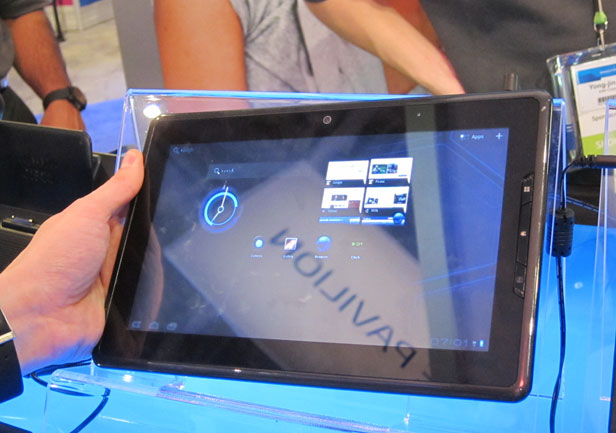Intel Chases a More Power-Efficient Future

Intel has announced a line of more power-efficient microprocessors for smart phones and tablets that could help recapture some of this increasingly valuable market segment. At the Intel Developers Forum (IDF) in San Francisco this week, the company also announced that it’s forming an alliance with Google to get the Android operating system released more quickly for Intel hardware.
Intel now finds itself in an unfamiliar, and uncomfortable, position. Having dominated the computer landscape for years by churning out faster and faster chips, it now lags behind in the race to create more energy-efficient microchips for smart phones and tablets—two rapidly growing hardware categories that are eating into sales of desktop and laptop computers.
The majority of smart phones and tablets on the market today, including the iPhone and iPad, use chips designed by ARM, a U.K. company that licenses microchip designs. Nvidia, Freescale, Texas Instruments, Samsung, and other companies manufacture ARM chips. The first Intel microchip aimed at the mobile market—the Atom—was released in 2008, but it proved less power-efficient than comparable ARM chips. Because battery life is prized in mobile devices, no major manufacturer is using Atom chips in its devices.
That could change next year. During his keynote speech at IDF 2011, Intel CEO Paul Otellini demonstrated a new version of Atom that promises to be much more power-efficient and capable than the original. The chip, code-named Medfield, is a refined Atom design that solves many issues that previously hurt the chip’s power efficiency. Otellini and Google’s Android chief, Andy Rubin, showed a prototype smart phone powered by the chip running the latest version of the Android operating system.
Intel and Google also announced on Tuesday that new versions of Android will be optimized for Intel hardware and released along with versions made for other hardware. That’s an important strategic move for Intel—in the past, it’s had to wait several months for new versions of Android to be ported to its hardware. The move could persuade hardware manufacturers to use Intel’s Atom instead of ARM-based chips, since they could launch their products more quickly. Intel-powered tablets running Android were also demoed on the floor of IDF 2011.
Not coincidentally, Microsoft, Intel’s longtime software collaborator, announced a similar strategic deal around the same moment that the Intel-Google announcement was made. At the Build conference, in Anaheim, California, an event also aimed at software developers, Microsoft revealed that it would make its next operating system, Windows 8, compatible with ARM chips. Windows 8 is designed to run on both touch-screen and conventional computers. The deal is a concern for Intel, partly because it could encourage smart-phone and tablet manufacturers to continue using ARM chips, but also, more worryingly, because it could help ARM make a transition to supplying chips for more powerful server and desktop computers, thereby posing a threat to Intel’s core business.
Quinn Bolton, a senior analyst specializing in semiconductor technology at equity research firm Needham, says another, more fundamental hardware innovation from Intel—a tri-gate, or three-dimensional processor made with components that are just 22 nanometers in size—could have an even bigger impact on Intel’s efforts to be more competitive in mobile.
The tri-gate design “improves device performance, but more important, significantly reduces leakage current and therefore power consumption relative to traditional transistor designs,” Bolton says. “As mobile devices are very sensitive to power consumption, the tri-gate architecture should enable Intel to further reduce the power consumption of its mobile-device processors without sacrificing performance.”
Intel could also be several years ahead of the competition in using this hardware. “It appears the rest of the industry is not likely to adopt tri-gate transistors in volume production until closer to the middle of this decade,” says Bolton. “I expect Intel will begin to manufacture its mobile-device processors using the new 22-nanometer tri-gate process technology in early 2013.”
Regardless of the advances, Intel hopes to squeeze further life out of its existing technology. At IDF, several computer makers demonstrated a new class of very light and thin laptops, dubbed an “ultrabook,” that uses an updated version of Intel’s line of laptop microprocessors.
The microprocessor used in these machines, code-named Ivy Bridge, is also made using a 22-nanometer process and includes greater on-board graphics capabilities as well as better performance. Intel’s longtime competitor AMD will launch its own line of chips to compete in this area.
The prototype ultrabooks on show at IDF 2011 used solid-state drives instead of spinning hard-disk drives, and offered battery life in excess of six hours. Most resemble Apple’s popular MacBook Air, but some were even thinner and lighter. The first are expected to go on sale in November, and some may sell for slightly less than Apple’s machine.
Keep Reading
Most Popular
Large language models can do jaw-dropping things. But nobody knows exactly why.
And that's a problem. Figuring it out is one of the biggest scientific puzzles of our time and a crucial step towards controlling more powerful future models.
The problem with plug-in hybrids? Their drivers.
Plug-in hybrids are often sold as a transition to EVs, but new data from Europe shows we’re still underestimating the emissions they produce.
Google DeepMind’s new generative model makes Super Mario–like games from scratch
Genie learns how to control games by watching hours and hours of video. It could help train next-gen robots too.
How scientists traced a mysterious covid case back to six toilets
When wastewater surveillance turns into a hunt for a single infected individual, the ethics get tricky.
Stay connected
Get the latest updates from
MIT Technology Review
Discover special offers, top stories, upcoming events, and more.